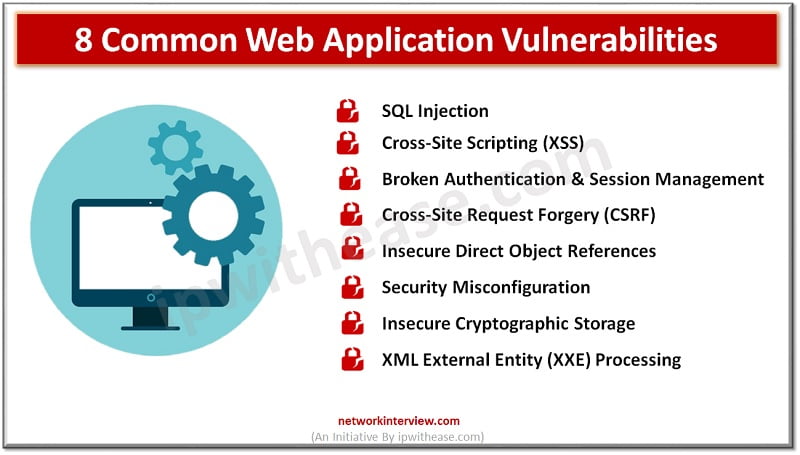
8 Common Web Application Vulnerabilities
Introduction to Web Application Vulnerabilities
Web application vulnerabilities are glitches or imperfections found in the system. These can lead to security risks, such as cyber-attacks or data breaches. Sadly, these risks occur more often than network or asset dangers. According to a recently released Verizon report, 26% of digital invasions were caused by web application attacks. This is because web applications are connected to different networks and are accessible to users around the world.
OWASP foundation releases a compilation of the ten most serious web application security issues every year. As technology evolves, the list continually changes as certain vulnerabilities become more dangerous and others become less dangerous. This article will provide the most common application vulnerabilities based on the OWASP reports.
List of Most Common Web Application Vulnerabilities
1. SQL Injection
Injection is a type of breach that permits a third party to modify back-end SQL instructions by manipulating the user-supplied data. This happens when the user input is transmitted to an interpreter as part of a command or query and deceives the interpreter into running unintended orders and granting access to data without permission. Furthermore, the execution of the SQL command by the web application can also uncover the back-end database.
2. Cross-Site Scripting (XSS)
XSS attacks are comparable to SQL injection attacks and include the injection of malicious scripts into sites or web applications. The distinction is that the malicious script runs in the program just when the client visits a bargain site or application. Attackers regularly execute XSS attacks by injecting code into input fields that the objective page runs when guests see the page (e.g., installed JavaScript interface).
A cross-site scripting attack can potentially reveal a user’s information without any warning or hint of a security breach, which can have a negative impact on a business’s reputation over a long period of time.
3. Broken Authentication and Session Management
Authentication assists applications to identify and confirm users. If authentication is faulty or not working properly, it can give unauthorized users the same access level as the targeted user, developing huge security issues for the web app. Issues with authentication can give a hacker free access to the data and cause severe damage to the web application.
Taking advantage of this vulnerability, a malicious individual can take control of a user’s session, attain unauthorized entry to the system which permits both the visibility and alteration of private data. The sessions can be seized by means of stolen cookies or sessions using XSS.
Using MFA, Generating secure passwords which are updated on a regular basis and proper timeouts configuration of the database helps prevent the authentication issues.
4. Cross-Site Request Forgery (CSRF)
A CSRF attack is triggered when an attacker encourages someone to take action on a website that they did not mean to. The user will have already logged into the web app, and it will recognize the individual and their browser as reliable. Subsequently, the malicious activities that the aggressor tricks the victim into sending a message to the web app will be executed. The inspiration for CSRF can range from silly jokes to facilitating illegal financial transactions.
5. Insecure Direct Object References
When the keys to a database or individual files are made visible to a user, it opens up a vulnerability known as insecure direct object reference. This gives the ability to attackers to use enumeration attacks and obtain access to the objects stored within, including confidential databases. Usually, there is either no authentication process or it is not working properly.
Serialized data keys that are accessible through URL parameters can be manipulated by an attacker to gain access to a database’s objects. Furthermore, an attacker can tamper with static files in order to access confidential information or the data of other users.
6. Security Misconfiguration
It is essential to set up and deploy security configurations for the application, frameworks, application server, web server, database server, and operating system. These are some requirements needed together with solutions like Fastnetmon that can offer network visibility and DDos attack detection and mitigation to ensure the protection and integrity of your network.
If these are not adequately established, a hacker can get access to sensitive information or features without authorization.
Sometimes these issues can lead to a full-scale system breach. It is also beneficial for security to keep the software up to date. Taking advantage of this security hole, the hacker can discover the type of technology and version of the application server being used, as well as any database data, in order to launch additional attack attempts.
7. Insecure Cryptographic Storage
A widespread security flaw is Insecure Cryptographic storage, which happens when delicate data is not kept safe. Username and password, account information, medical information, credit card numbers, etc. fall into the category of sensitive data on a website.
This information is usually put away on the application database. When it is not safeguarded with encryption or hashing, it can be exposed to hackers.
Taking advantage of this security loophole, a malicious individual can take, alter unprotected data for the purpose of identity fraud, credit card fraud and other illicit activities.
8. XML External Entity (XXE) Processing
An XXE (XML External Entity) attack is when a hacker abuses the common components of XML parsers to gain access to data files remotely or on the local network, commonly leading to a Denial of Service (DoS). This malicious activity can also be employed to instigate SSRF (Server-Side Request Forgery) attacks, which compel the web application to make external, harmful requests. In addition, XXE can be used by attackers to conduct port scanning and run malicious code remotely.
Continue Reading:
Cloud App vs Web App : Detailed Comparison
Top 10 Application Monitoring Tools (APM)
Tag:Security



